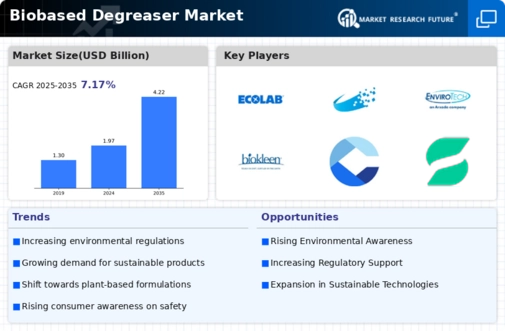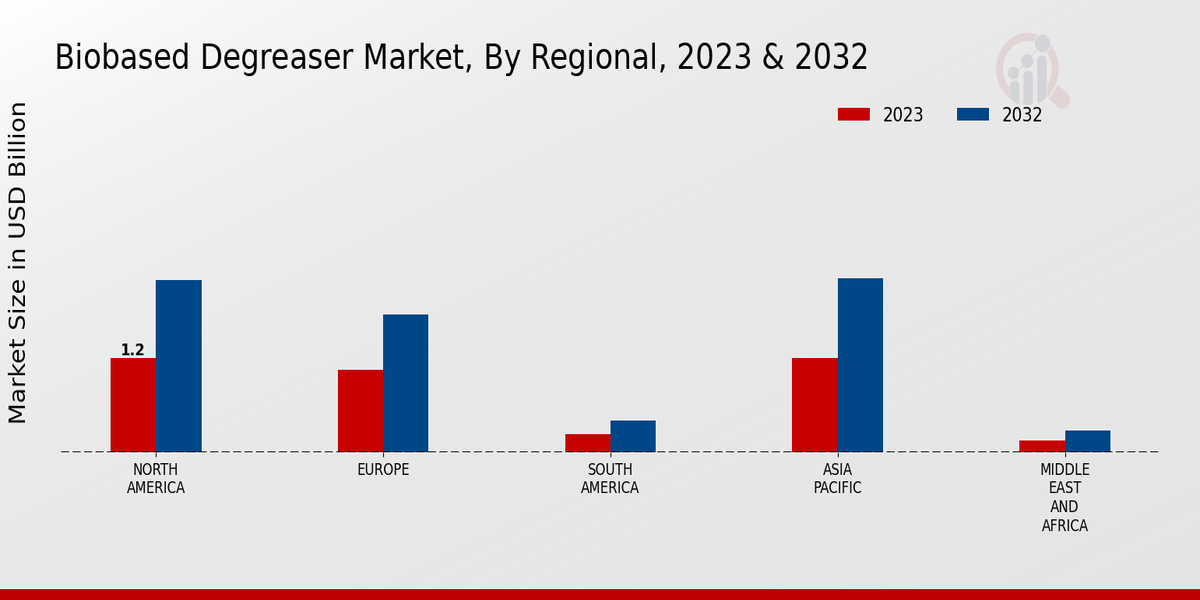Market Growth Projections
The Global Biobased Degreaser Market Industry is poised for substantial growth, as indicated by market projections. The market is expected to reach a value of 1.97 USD Billion in 2024, with a robust compound annual growth rate of 7.18% anticipated from 2025 to 2035. This growth trajectory reflects the increasing adoption of biobased cleaning solutions across various sectors, driven by environmental regulations and consumer preferences. The anticipated market value of 4.22 USD Billion by 2035 underscores the potential for biobased degreasers to capture a significant share of the cleaning products market, highlighting their relevance in a sustainable future.
Growing Environmental Awareness
The increasing global emphasis on sustainability and environmental protection drives the Global Biobased Degreaser Market Industry. Consumers and industries are becoming more conscious of the ecological impact of traditional solvents, leading to a shift towards biobased alternatives. This trend is evident as companies seek to reduce their carbon footprint and comply with stringent environmental regulations. For instance, biobased degreasers, derived from renewable resources, are gaining traction in sectors such as automotive and manufacturing. The market is projected to reach 1.97 USD Billion in 2024, reflecting a growing preference for eco-friendly cleaning solutions.
Rising Demand from Industrial Sectors
The demand for biobased degreasers is surging across various industrial sectors, significantly impacting the Global Biobased Degreaser Market Industry. Industries such as automotive, aerospace, and manufacturing are increasingly adopting these products due to their effectiveness and lower environmental impact. For example, automotive manufacturers are utilizing biobased degreasers for parts cleaning, aligning with sustainability goals. This trend is expected to contribute to the market's growth, with projections suggesting a market value of 1.97 USD Billion in 2024. The shift towards sustainable practices in these sectors underscores the potential for biobased degreasers to become mainstream cleaning solutions.
Regulatory Support for Biobased Products
Government initiatives and regulations promoting the use of biobased products significantly influence the Global Biobased Degreaser Market Industry. Policies aimed at reducing hazardous substances in industrial cleaning agents encourage manufacturers to develop safer, biobased alternatives. For example, the U.S. Environmental Protection Agency has established guidelines that favor the adoption of environmentally friendly products. Such regulatory frameworks not only facilitate market entry for biobased degreasers but also enhance consumer confidence in these products. As a result, the market is expected to grow substantially, with projections indicating a value of 4.22 USD Billion by 2035.
Technological Advancements in Formulation
Innovations in formulation technologies are propelling the Global Biobased Degreaser Market Industry forward. Advances in chemistry enable the development of more effective biobased degreasers that rival traditional solvents in performance. For instance, the incorporation of enzymes and surfactants derived from natural sources enhances the cleaning efficacy of these products. This technological evolution not only improves product performance but also broadens the application scope across various industries, including food processing and aerospace. As a result, the market is anticipated to witness a compound annual growth rate of 7.18% from 2025 to 2035, indicating robust growth driven by innovation.
Consumer Preference for Eco-Friendly Products
A notable shift in consumer preferences towards eco-friendly products is shaping the Global Biobased Degreaser Market Industry. As consumers become more informed about the environmental and health implications of cleaning agents, they are increasingly opting for biobased alternatives. This trend is particularly pronounced among environmentally conscious consumers who prioritize sustainability in their purchasing decisions. Retailers are responding by expanding their offerings of biobased degreasers, catering to this growing demand. Consequently, the market is poised for significant growth, with expectations of reaching 4.22 USD Billion by 2035, driven by changing consumer behavior.





















